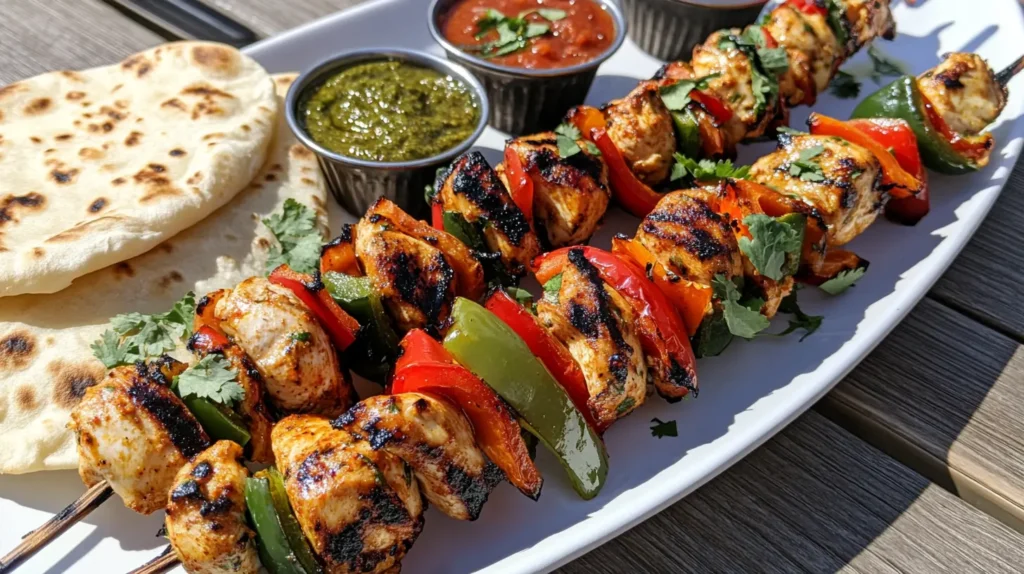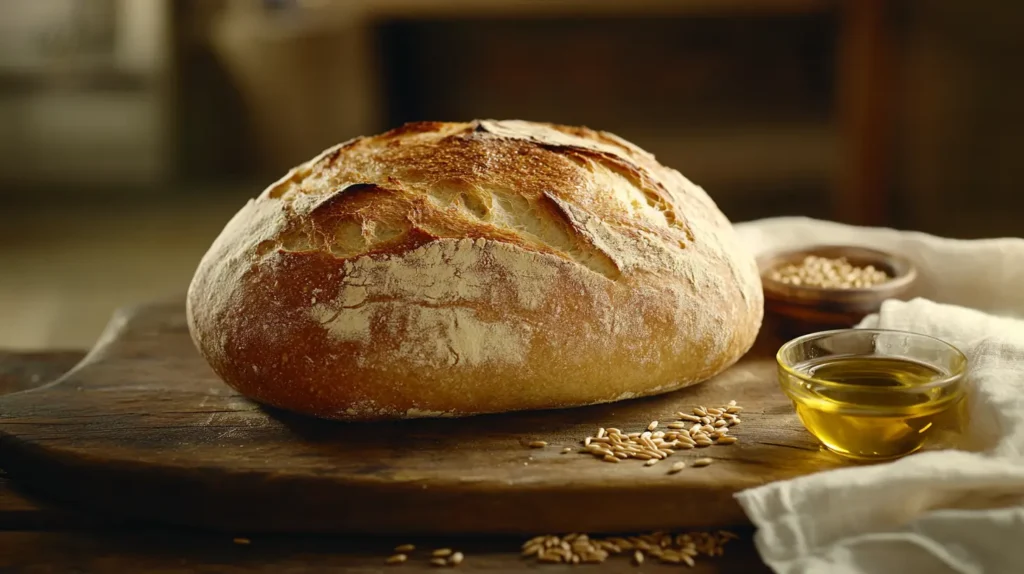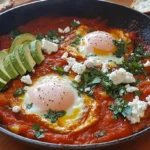Nestled in the heart of Moroccan cuisine, shakshuka is a vibrant culinary masterpiece that tantalizes taste buds with its rich, spicy essence. Moreover, this delectable dish transforms simple ingredients into a remarkable gastronomic experience. Shakshuka features perfectly poached eggs gently nestled in a robust, fiery tomato sauce, creating a harmonious blend of flavors and textures. Originating from North Africa, specifically Tunisia, this dish has beautifully transcended its regional roots to become a global breakfast sensation. Furthermore, its versatility allows it to be enjoyed for breakfast, lunch, or dinner. Indeed, the name “shakshuka” itself means “a mixture” in Arabic, perfectly capturing the dynamic combination of ingredients. Whether served in a cozy Moroccan café or prepared in home kitchens worldwide, this dish continues to captivate food lovers with its bold, comforting appeal.
A Brief History of Shakshuka
Shakshuka’s roots can be traced back to Tunisia, but it has become synonymous with Moroccan cuisine. The name itself means “a mixture” in Arabic, which is fitting because it’s a beautiful blend of flavors and textures. Traditionally, it was a meal for breakfast or brunch, but let’s be honest—who says you can’t enjoy it for dinner too? It’s like a warm hug on a plate, perfect for any time of the day.

Differences Between Moroccan and Other Shakshuka
You might wonder, “What sets Moroccan shakshuka apart from other versions?” Well, it’s all about the spices! While many shakshuka recipes use a basic tomato sauce, Moroccan shakshuka often includes a medley of spices like cumin, paprika, and harissa, giving it a unique kick. Think of it as the difference between a regular pizza and a gourmet one topped with exotic ingredients.
Key Ingredients in Moroccan Shakshuka
Now that we grasp what shakshuka is, let’s dive into the key ingredients that make this dish special.
The Role of Spices in Moroccan Shakshuka
Spices are the heart and soul of Moroccan cuisine. They don’t just add flavor; they tell a story. Combining cumin, coriander, and paprika creates a warm, aromatic base that tantalizes your taste buds. Imagine walking through a bustling market filled with colorful spices, each promising a new adventure.
Fresh Vegetables and Their Importance
Fresh vegetables are equally important in shakshuka. Tomatoes are the show’s star, but don’t forget about bell peppers, onions, and garlic. These ingredients add not only depth but also a burst of color. When you cook them down, they create a luscious sauce that envelops the eggs like a cozy blanket.
Eggs: The Heart of Shakshuka
And let’s not overlook the eggs! They’re the pièce de résistance. When you crack them into the simmering sauce, they poach gently, absorbing all those incredible flavors. The result? A creamy yolk that oozes into the sauce with every bite. It’s like a little explosion of happiness on your plate!
How to Make Authentic Moroccan Shakshuka
Ready to get cooking? Making Moroccan shakshuka at home is easier than you might think. Let’s walk through a step-by-step recipe to make your kitchen smell divine.
Step-by-Step Recipe
Ingredients
| Ingredient | Quantity |
|---|---|
| Olive oil | 2 tablespoons |
| Onion | 1 large, diced |
| Bell pepper | 1 medium, diced |
| Garlic | 3 cloves, minced |
| Canned tomatoes | 1 can (14 oz) |
| Tomato paste | 2 tablespoons |
| Ground cumin | 1 teaspoon |
| Paprika | 1 teaspoon |
| Harissa | 1 tablespoon |
| Eggs | 4 large |
| Fresh parsley | For garnish |
| Salt and pepper | To taste |
Instructions
- Heat the Oil: Heat the olive oil in a large skillet over medium heat. The oil should shimmer but not smoke.
- Sauté the Vegetables: Add the diced onion and bell pepper. Sauté for about 5-7 minutes until they’re soft and fragrant. This is where the magic begins!
- Add Garlic and Spices: Toss in the minced garlic, cumin, paprika, and harissa. Stir everything together for about a minute until the spices become aromatic.
- Incorporate the Tomatoes: Pour in the canned tomatoes and tomato paste. Stir well, and let the mixture simmer for 10-15 minutes. This is where the sauce thickens and intensifies in flavor.
- Create Wells for the Eggs: Using a spoon, create little wells in the sauce and crack an egg into each well.
- Poach the Eggs: Cover the skillet and cook the eggs for 5-7 minutes, or until the whites are set but the yolks are still runny.
- Garnish and Serve: Sprinkle fresh parsley and season with salt and pepper. Serve with crusty bread for dipping!
Tips for Perfecting Your Moroccan Shakshuka
- Use Fresh Ingredients: Fresh vegetables and high-quality canned tomatoes make a difference.
- Adjust the Spice Level: Add more harissa or a pinch of cayenne pepper if you like heat.
- Experiment with Add-Ins: To twist the classic recipe, you can add ingredients like feta cheese, olives, or even cooked sausage.
“Cooking is like love. It should be entered into with abandon or not at all.” – Harriet Van Horne
Common Problems When Making Moroccan Shakshuka
Even the best chefs encounter kitchen hiccups. Here are some common problems you might face when making shakshuka and how to solve them.
Eggs Not Cooking Properly
If your eggs aren’t cooking through, try lowering the heat and covering the skillet. This helps trap steam and cook the eggs evenly. Remember, patience is key!
Sauce Too Watery or Thick
If your sauce is too watery, reduce it by simmering it longer. If it’s too thick, add a splash of water or broth to loosen it up. Think of it as adjusting the consistency of your favorite smoothie!
Lack of Flavor: How to Enhance Your Dish
If your shakshuka tastes a bit flat, don’t hesitate to add more spices or a splash of vinegar for acidity. Sometimes, extra seasoning can elevate your dish from good to unforgettable.
Variations of Moroccan Shakshuka
One of the best things about Moroccan shakshuka is its versatility. You can easily customize it to suit your taste or dietary preferences. Let’s explore some delightful variations that will keep your shakshuka game strong!
Vegetarian and Vegan Options
For those who prefer a plant-based diet, fear not! Moroccan shakshuka can easily be made vegetarian or vegan without sacrificing flavor. Here are some ideas:
- Chickpea Shakshuka: Add a can of drained chickpeas to the sauce for protein and texture. They soak up the flavors beautifully and make the dish heartier.
- Spinach and Feta: Toss in fresh spinach just before cracking the eggs. The wilted greens add vibrant colour and a nutritious boost. Crumble some feta cheese on top before serving for a creamy twist.
- Zucchini and Eggplant: Sauté diced zucchini, eggplant, onions, and bell peppers. These veggies add depth and a lovely earthiness to your shakshuka.

Adding Meat: Traditional Variations to Moroccan Shakshuka
You can also incorporate various meats into your shakshuka if you’re a meat lover. Here are a couple of traditional variations:
- Merguez Sausage: This spicy North African sausage is a fantastic addition to the dish. Slice it up and brown it in the skillet before adding the vegetables. The sausage infuses the sauce with its rich flavor.
- Chicken Shashlika: For a heartier meal, you can add cooked, shredded chicken to the sauce. This is a great way to use leftovers and add a satisfying protein element.

Creative Twists for Moroccan Shakshuka
Feeling adventurous? Here are some creative twists to shake things up:
- Cheesy Shakshuka: For cheese lovers, sprinkle shredded mozzarella or cheddar over the eggs just before covering the skillet. Let it melt for a gooey, indulgent treat.
- Mediterranean Style: For a Mediterranean flair, add olives, sun-dried tomatoes, and artichokes. This combination adds a tangy, savory touch that’s simply irresistible.
Serving Suggestions for Moroccan Shakshuka
Now that you’ve made a delicious shakshuka, you should consider how to serve it. Presentation matters and there are plenty of ways to make your dish shine!
Best Accompaniments
Shakshuka is often served with bread, and for good reason! Here are some tasty options:
- Crusty Bread: A fresh baguette or crusty sourdough is perfect for scooping up the sauce and yolks. It’s like a match made in heaven!
- Pita Bread: Soft pita bread can be torn and dipped into the shakshuka. You can even toast it for extra crunch.
- Flatbreads: Try serving your shakshuka with homemade or store-bought flatbreads. They’re perfect for wrapping around the delicious mixture.

Pairing with Bread and Other Sides
While bread is a classic pairing, you can also consider these sides to elevate your meal:
- Salad: A light, refreshing salad with cucumbers, tomatoes, and a drizzle of olive oil can balance the richness of the shakshuka.
- Yogurt: A dollop of plain yogurt or labneh on the side adds creaminess and a cooling effect, perfect for balancing the spices.
- Pickles: Tangy pickles or preserved lemons can enhance the flavors and add a delightful crunch to your meal.
“Food is symbolic of love when words are inadequate.” – Alan D. Wolfelt
Beverage Pairings for Moroccan Shakshuka
No meal is complete without the perfect drink to complement its flavors. Moroccan shakshuka is rich, bold, and packed with spices, making it ideal for pairing with refreshing beverages. Here are two great drink options to enjoy with your shakshuka:
1. Moroccan Mint Tea
A classic Moroccan meal isn’t complete without Moroccan Mint Tea. This fragrant, sweetened green tea infused with fresh mint leaves is the perfect way to balance shakshuka’s warm, spiced flavors. Its refreshing nature helps cleanse the palate, making every bite of your dish as enjoyable as the first.
2. Hibiscus Iced Tea
Hibiscus Iced Tea is an excellent choice for a cold, slick, tangy drink. This vibrant red tea has a naturally tart flavor with floral undertones that beautifully contrast with the richness of shakshuka. Plus, its high antioxidant content makes it a healthy and delicious option.
Health Benefits of Moroccan Shakshuka
Shakshuka is delicious and packed with nutritional benefits. Let’s explore what makes this dish a great health choice.
Nutritional Value of Ingredients
Here’s a quick look at the nutritional benefits of some key ingredients in shakshuka:
| Ingredient | Nutritional Benefit |
|---|---|
| Eggs | High in protein and essential nutrients |
| Tomatoes | Rich in vitamins C and K, plus antioxidants |
| Bell Peppers | Loaded with vitamins A and C |
| Olive Oil | Contains healthy fats and antioxidants |
| Spices (Cumin, Paprika) | Anti-inflammatory properties and rich flavor |
Shakshuka as a Balanced Meal
When you combine all these ingredients, you create a balanced, satisfying, and nourishing meal. The protein from the eggs, the vitamins from the vegetables, and the healthy fats from the olive oil work together to provide a wholesome dish.
Shakshuka is also naturally low in carbohydrates, making it a great option for those watching their carb intake. Plus, it’s gluten-free, so it caters to various dietary needs!
Final Thoughts on Moroccan Shakshuka
As we conclude this ultimate guide to Moroccan shakshuka, it’s clear that this dish is more than just a recipe; it celebrates flavors, culture, and community. Whether you enjoy it at a café in Marrakech or whip it up in your own kitchen, shakshuka brings warmth and joy to the table.
Embrace the Experience
So, gather your ingredients, invite some friends over, and make a meal out of it! Cooking can be a fun and interactive experience, and shakshuka is perfect for sharing. Picture this: a vibrant skillet of shakshuka at the center of your table, everyone digging in, laughing, and enjoying each other’s company. It’s not just food; it’s a moment to cherish.
Explore and Experiment
Don’t hesitate to explore different variations and make this dish your own. Whether you stick to the traditional recipe or add your unique twist, the key is to enjoy the process. Cooking should be fun and creative, so let your imagination run wild!
“Cooking is like love; it should be entered into with abandon or not at all.” – Harriet Van Horne
Explore our Main-Course Recipe of Thin Sliced Chicken Breast to enhance your cooking experience
Join the Shakshuka Revolution!
Now that you have all this knowledge, it’s time to join the shakshuka revolution! Share your experience in the comments below, connect with fellow food lovers, and inspire others to try this delightful dish. Who knows? You might just become the shakshuka guru among your friends!
Conclusion
Moroccan shakshuka is more than just a dish; it’s an experience. From its rich history and vibrant flavors to its versatility and health benefits, shakshuka has something for everyone. Whether you enjoy it for breakfast, lunch, or dinner, this dish will warm your heart and satisfy your taste buds. Happy cooking!
Frequently Asked Questions about Moroccan Shakshuka
As we wrap up our exploration of Moroccan shakshuka, let’s address some common questions that many people have about this delightful dish. Whether you’re a seasoned cook or a curious beginner, these FAQs will help you confidently navigate the world of shakshuka.
How to Make Shakshuka?
Making shakshuka is easier than you might think! Here’s a quick recap of the steps:
- Sauté Vegetables: Start with olive oil, then sauté onions and bell peppers until soft.
- Add Spices: Incorporate garlic, cumin, paprika, and harissa for flavor.
- Tomatoes: Stir in canned tomatoes and tomato paste, letting them simmer until thick.
- Poach Eggs: Create wells in the sauce, crack in the eggs, cover, and let them poach until the whites are set.
- Serve: Garnish with fresh parsley and enjoy with your favorite bread!
This simple process allows you to create a flavorful dish in no time. Plus, you can customize it with various ingredients to suit your taste!
Where is Shakshuka From?
Shakshuka is a North African dish most commonly associated with Tunisia. Over time, it has become a beloved dish in many countries, particularly Morocco, where it has been embraced and adapted. Each region adds its unique twist, but the essence of shakshuka—poached eggs in a spicy tomato sauce—remains the same. It’s like a culinary journey across cultures, bringing people together through food.
Is Shakshuka Keto?
Yes, shakshuka can be a great option for those following a keto diet! The dish is naturally low in carbohydrates, primarily because it focuses on eggs and vegetables. If you skip the bread and stick to the shakshuka itself, you can enjoy a satisfying meal that fits well within a keto lifestyle. Just keep an eye on any additional ingredients you might add, like potatoes or bread, which can increase the carb count.
What to Eat with Shakshuka?
Shakshuka is delicious on its own, but it’s even better when paired with the right accompaniments. Here are some ideas:
- Crusty Bread: Perfect for dipping and soaking up that rich sauce.
- Pita or Flatbread: Soft and versatile, great for scooping.
- Yogurt: A cooling side that balances the spices beautifully.
- Salad: A light, refreshing salad can provide a nice contrast to the warm shakshuka.
- Pickles: Tangy pickles or preserved lemons add a delightful crunch and acidity.
These sides enhance the meal and create a well-rounded dining experience.



